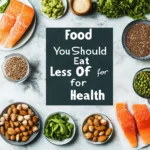Description
This comprehensive guide outlines the three foods you should eat less of to stay healthy based on scientific research. Learn about processed meats, refined sugars, and ultra-processed snacks, plus discover healthier alternatives that support optimal nutrition and long-term wellness.
Ingredients
- Knowledge: Understanding of food labels and nutrition facts
- Awareness: Recognition of processed vs. whole foods
- Planning: Meal planning and preparation skills
- Alternatives: List of healthy substitutions for each food category
- Commitment: Dedication to gradual, sustainable dietary changes
Instructions
- Identify Processed Meats: Review your current diet and identify processed meats like bacon, hot dogs, deli meats, and sausages. Read labels to understand sodium and preservative content.
- Find Fresh Protein Alternatives: Replace processed meats with fresh chicken breast, wild-caught fish, grass-fed beef, or plant-based proteins like lentils and quinoa.
- Locate Hidden Sugars: Examine food labels for added sugars under names like high fructose corn syrup, agave nectar, and dextrose. Track your daily sugar intake.
- Choose Natural Sweeteners: Substitute refined sugars with whole fruits, raw honey, pure maple syrup, or stevia in moderation.
- Eliminate Ultra-Processed Snacks: Remove chips, packaged cookies, crackers, and convenience foods from your pantry and shopping list.
- Stock Healthy Snacks: Fill your kitchen with fresh vegetables, raw nuts, seeds, Greek yogurt, and whole fruits for satisfying alternatives.
- Plan Weekly Meals: Create meal plans featuring whole foods and prepare ingredients in advance to avoid processed convenience options.
- Read Labels Consistently: Make label reading a habit, focusing on ingredient lists, sodium content, and added sugar amounts.
- Track Your Progress: Monitor how you feel after reducing these foods – note energy levels, digestion, and overall well-being improvements.
Notes
Important Reminders:
- Start with small, gradual changes rather than eliminating all three food categories at once
- Focus on adding healthy foods rather than just restricting problematic ones
- Occasional consumption of these foods won’t cause immediate harm – consistency matters most
- Consult with a healthcare provider before making significant dietary changes, especially if you have existing health conditions
- Remember that sustainable changes take time – be patient with yourself during the transition
- Keep healthy alternatives easily accessible to prevent reverting to processed options
- Prep Time: 15 minutes
- Cook Time: 0 minutes
- Category: Healthy Living Guide
- Method: Dietary Modification
- Cuisine: Health & Wellness
Nutrition
- Serving Size: Daily dietary awareness
- Calories: Varies by food choices
- Sugar: Significantly reduced
- Sodium: Substantially lowered
- Fat: Improved fat quality
- Saturated Fat: Reduced from processed sources
- Unsaturated Fat: Increased from whole food sources
- Trans Fat: Eliminated
- Carbohydrates: Focus on complex carbs
- Fiber: Increased from whole foods
- Protein: High-quality, complete proteins
- Cholesterol: Improved through better food choices
Keywords: foods you should eat less of, healthy eating tips, processed foods to avoid, clean eating guide, nutrition advice, anti-inflammatory diet, whole foods nutrition, dietary changes for health
